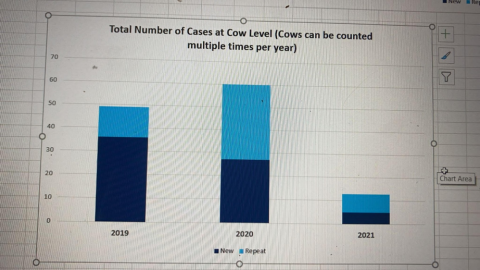Project Update: Graig Olway Mobility – Two Years On
Financially, score 3 cow cost £4.50/day and a Score 2 cow £1.50/day, at the beginning of the year, the lameness at Graig Olway was resulting in economic losses of £138/day or £50,370/year. There is a need to implement new tools and take a whole farm approach to reduce the impact of lameness on welfare and production. Sara Pedersen of Farm Dynamics has been working closely with Russel and the team at Graig Olway to improve herd mobility.
In January 2020 we mobility scored the whole herd at Graig Olway, and ran all cows through the foot trimming crush to have a baseline to work on. Cows that showed sign of Digital Dermatitis were given the blitz treatment, using licensed topical antibiotics treatment and re-examined for two consecutive days and repeat treatments given where necessary. The treatment worked great, with only a couple of lesions found over the last two years but have been picked up early and treated.
Although scores have been up and down throughout the period, on the whole lameness levels are much lower. Sarah has been mobility scoring fortnightly on weekends to draw up a trimming list for the trimmer mid-week. Scoring has been very sensitive, with Sarah scoring tough to ensure we pick up the feet early to reduce long-term chronic cases of lameness, especially with heifers.
Mobility is affected by a range of things, from cow comfort, trimming, treatment and nutrition. During summer 2020 lameness peaked at over 40%, which was mostly down to heat stress and over trimming which caused thin soles. As the cows are housed all year round, getting cow comfort to optimum level is key due to the pressure on the cows’ feet on concrete.
An action plan was created to ensure we didn’t see the same issue again the following summer. Russell invested in new mattrasses, along with rubber mats around the pressure points; cross overs and around the robots. As a short-term solution, some of the yorkshire boarding panels were removed to allow better air flow, along with raising some of the roof ridges or increasing the height.
Included in the action plan were small changes to management; scrape out dry cow shed daily, footbath dry cows more often and scraping crossover passages in sheds more frequently. All of which reduced the risk of lameness.
As we headed into winter, scores floated between 25-30% but we were now seeing the benefits of early detection. We discussed going back to monthly scoring but Russel and the team felt that early detection was the main driver, especially with sensitive scoring.
Fans were repositioned aroung the shed early summer to ensuremaximum effect. Cows looked much more content in the cubicles (as seen in the photo).
In the heifer shed, yokes were used as the feed barrier. As the main herd looked much more comfortable with less competition for space and feed, Russel replaced the yokes in the heifer shed with feed rail also to reduce pressure on the feet.
The weather turned hotter again, and this did have some effect on lameness levels. Sara explains that due to the historic nature of lameness and so much being dependent on a cow’s history. In August 2021, two thirds of the cows that went lame this score have had a history of lameness in the last 12 weeks. We had a lot of cows with underlying damage that just sit on the threshold and so it can swing either way with heat or disturbances. However, compared to August 2020 when lameness was at its worst, in August 2021 chronically lame cows were down by more than two thirds and lameness more than halved; lameness reduced proportionally by 70%.
Sara Pedersen did some number crunching in October, specifically looking at sole ulcers. Of the 5 ‘new’ cases this year, 4 have chronic history of sole bruising on that foot.
Graph 1. Total number of cases at cow level.
Having a close relationship with the foot trimmer has also been a key driver in the project, and will be a valuable aspect that Russel will carry on with. All records are precisely kept with the trimmer and Russel inputting data to the same software. This also allows Sara to analyse the data, see any new patterns and detect a possible issue. A complete list of cows to be trimmed is drawn up fortnightly, which includes:
- In-calf heifers 8 weeks before calving
- Cows to be dried off
- 60-90 DIM
- Lame cows
- Re-checks of previous lame cows


